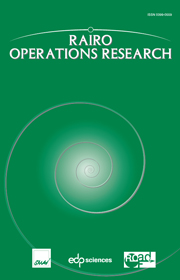Article contents
Minimization of communication expenditure for seasonal products
Published online by Cambridge University Press: 15 December 2002
Abstract
We consider a firmthat sells seasonal goods. The firm seeks to reach a fixed levelof goodwill at the end of the selling period, with the minimumtotal expenditure in promotional activities. We consider thelinear optimal control problem faced by the firm which can onlycontrol the communication expenditure rate; communication isperformed by means of advertising and sales promotion. Goodwilland sales levels are considered as state variables andword-of-mouth effect and saturation aversion are taken intoaccount. The optimal control problem is addressed by means of theclassical Pontryagin Maximum Principle and the solution can beeasily found solving, in some cases numerically, a system of twonon linear equations. Moreover, a parametric analysis is performedto understand how the total expenditure in communication shouldbe divided between advertising and sales promotion.
- Type
- Research Article
- Information
- Copyright
- © EDP Sciences, 2002
References
- 8
- Cited by


